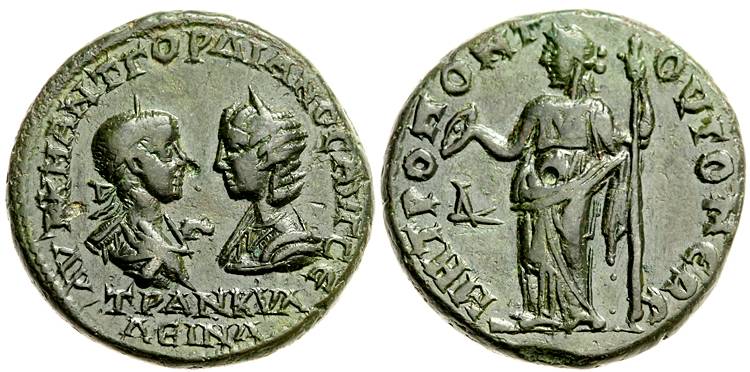
|
Tomis - 4.5 assaria - Gordian III and Tranquillina / Hera |
|

| |
|
26 mm diameter, 12.65 g, bronze Obverse: confronted busts of Gordian III and Sabinia Tranquillina, cuirassed and draped Gordian III to the right, draped Sabinia Tranquillina to the left, wearing "stephane" crown, legend AV TKMANTΓOPΔIANOCAVΓCE TPANKVΛ ΛEINA, outer pearl circle | Reverse: Hera standing, head to the left, wearing chiton and himation, patera in extended right hand, with scepter in left hand, value D< (Δ<, written as ligature) into the field, legend MHTPOΠONT OVTOMEΩC, outer pearl circle |
The ancient coin pictures above are present on Romanian coins through the kind permission of VAuctions.
The coin corresponds to the description at number 2287 in the Moushmov catalog and is described in AMNG I at position 3518 (AMNG = Die antiken Münzen Nord-Griechenlands, B. Pick, 1898).
About the denomination of the coin
The denomination value is marked by letter Δ together with sign <. Letter Δ being the fourth of the alphabet, stands for the value of 4. The half of assarion was marked by an <, so the coin is worth 4.5 assaria.
The coins of 4 assaria and a half are specific to Tomis, while the design with confronted busts is specific to the provincial large 5 assaria pieces. A possible explanation was proposed here. These coin were local coins. In spite of the fact that the value of 1 denarius was, officially, 16 asses, it is quite possible that in local money the denarius was worth more. If 1 Roman denarius was equal with 18 asses from Tomis, than it could be exchanged for four coins of 4.5 assaria. In that case the issue of coins having such unusual denomination can be explained by the need of coins fit for money exchanges.
About the legend on the obverse
The legend accompanying the busts of emperor Gordian III and of his wife Tranquillina is AVT K M ANT ΓOPΔIANOC AVΓ CE TPANKVΛΛEINA, standing for the Greek translation of Latin IMPERATOR CAESAR MARCUS ANTONIUS GORDIANUS AUGUSTUS and TRANQUILLINA AUGUSTA.
About Greek goddess Hera
Hera (Juno at Romans) was sister and wife of Zeus, being daughter of Cronus and Rhea. She was mother of Ares, Greek god of war, and also of Hephaestus, god of craftsmen. She was protector of married women and of marriage. Because Zeus was renowned for his infidelities, Hera was very jealous on her numerous rivals. Her revenges were often terrible. She spread her rage also over men, Heracles, for example, having been persecuted by Hera during his entire mortal life (before he bore name of Alcides, after the conflict with Hera and his atonement of twelve labours being known as Hera kleos = Glory of Hera). Durind Trojan War the goddess supported the Greek part, as Paris had given the golden apple to Aphrodite and not to herself or Athena.
|
Back to selection page!
|